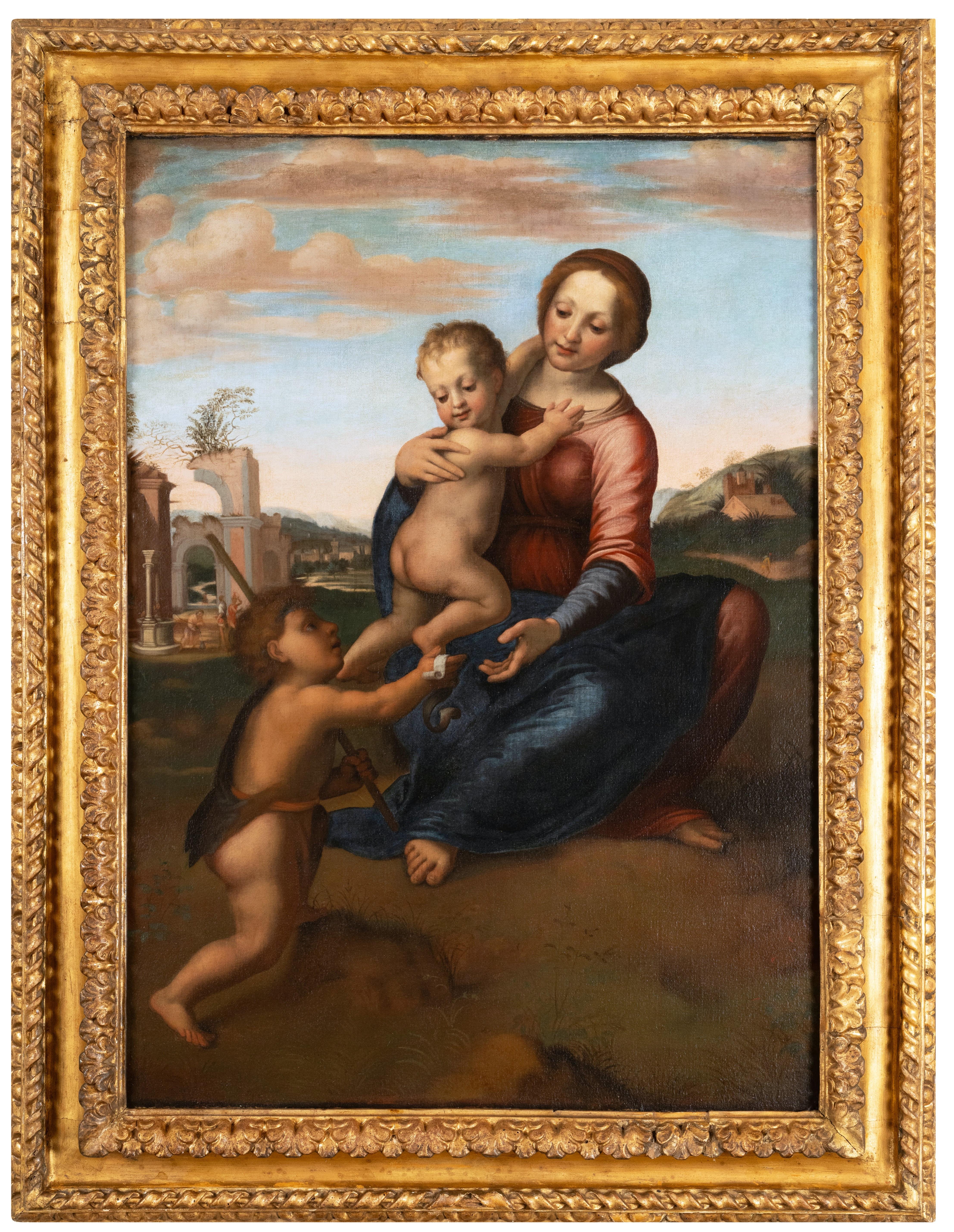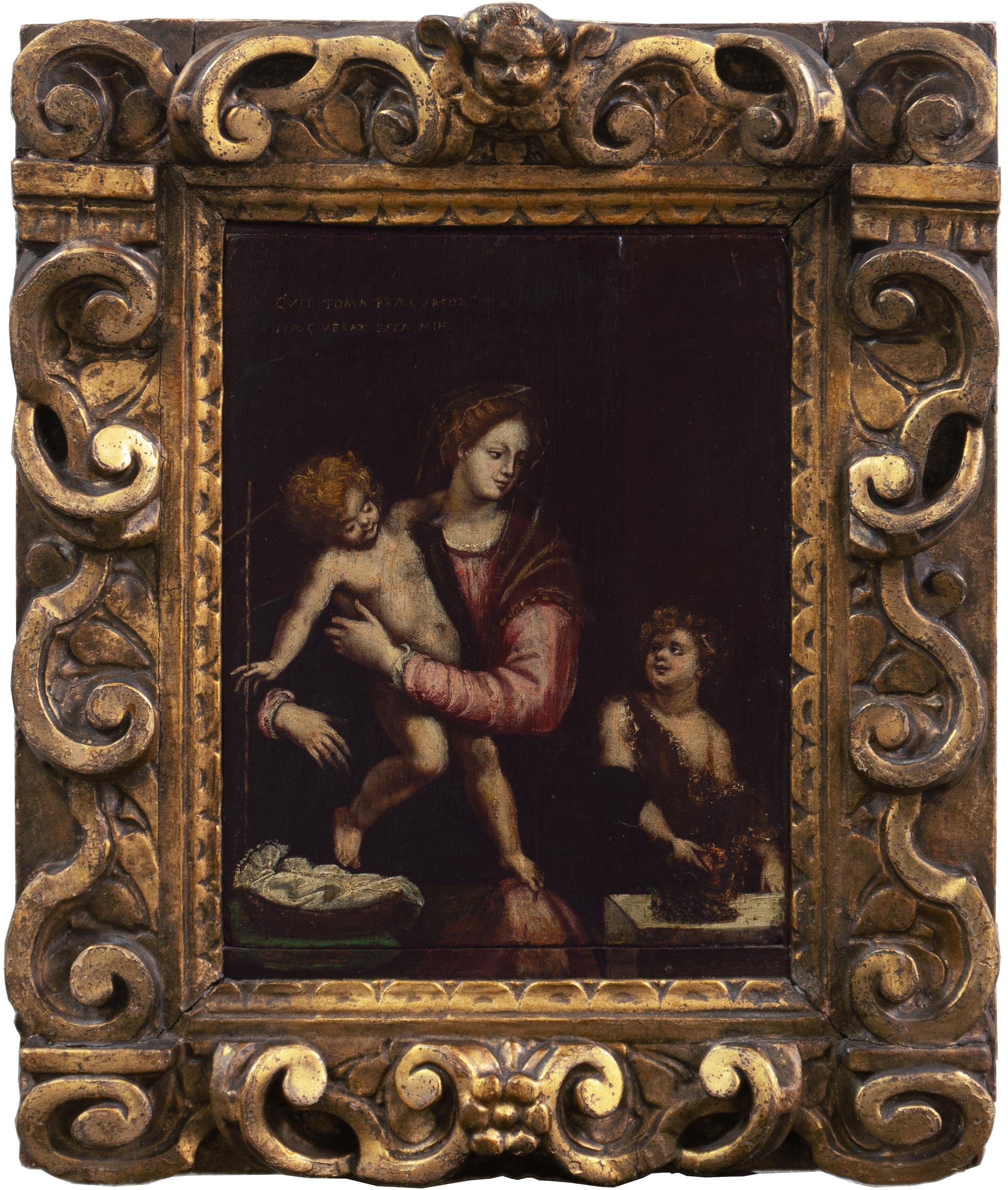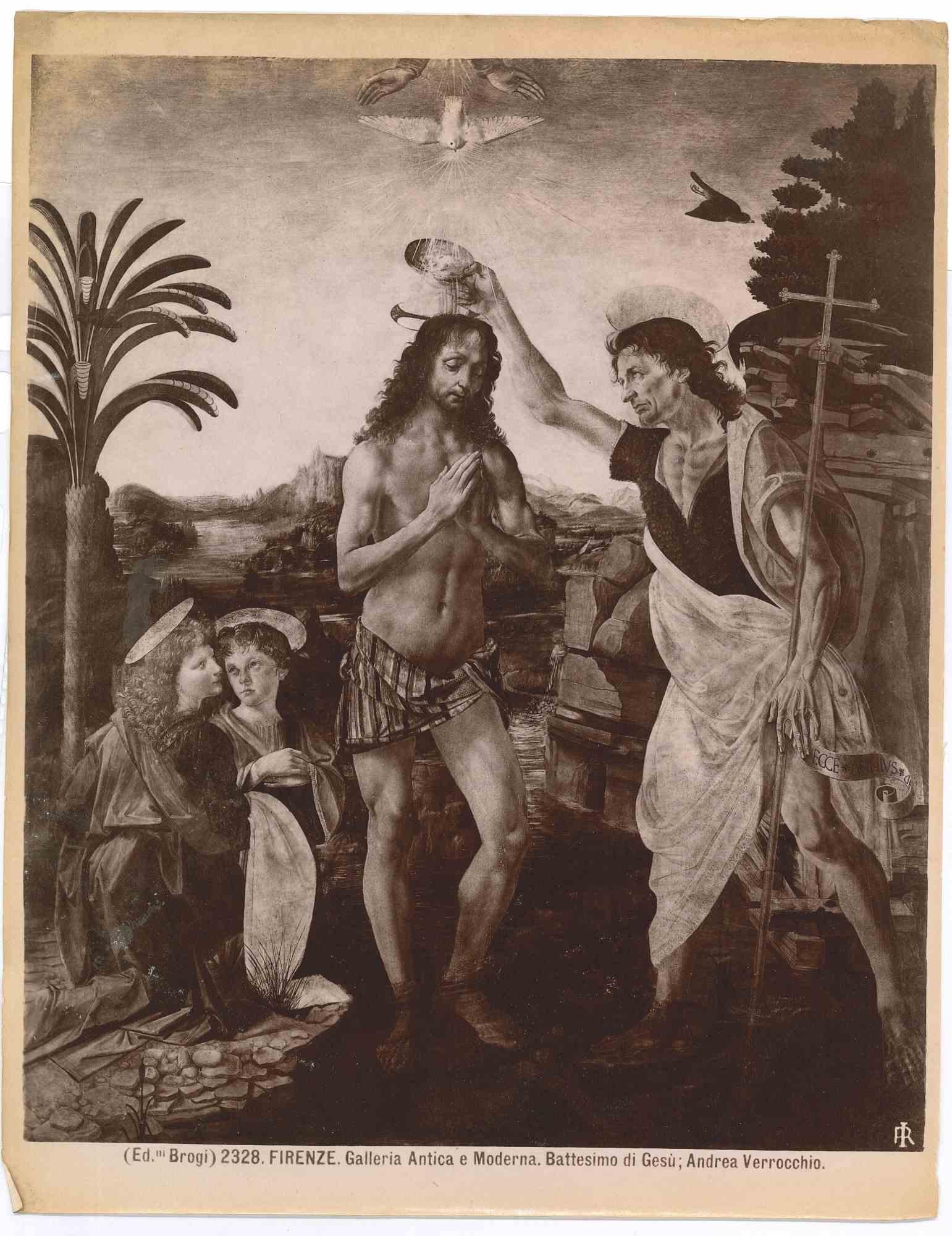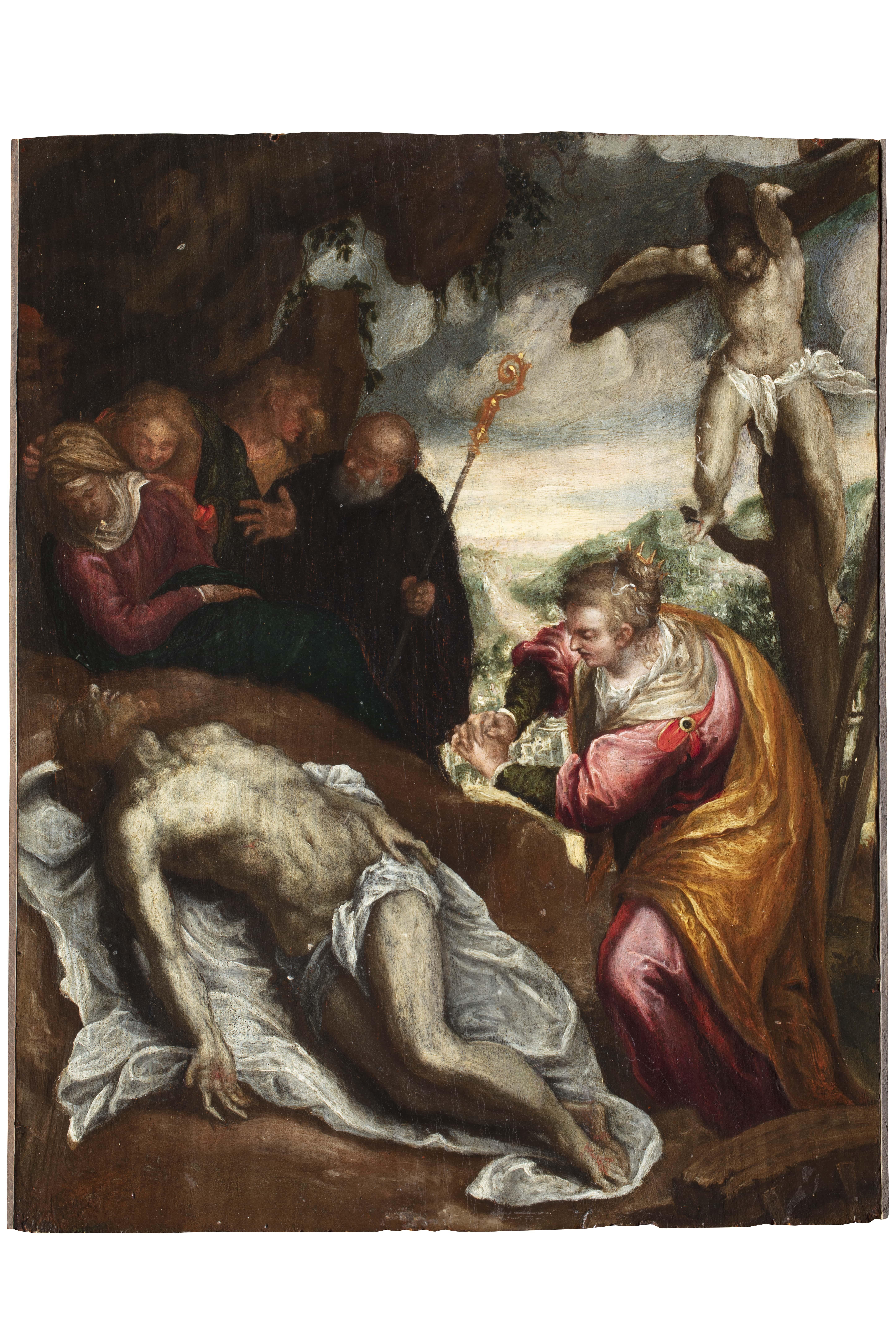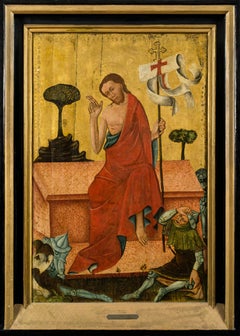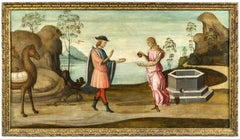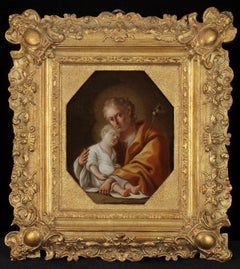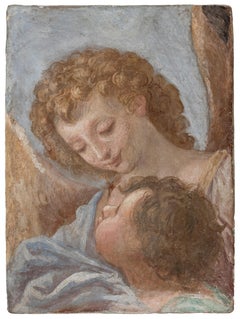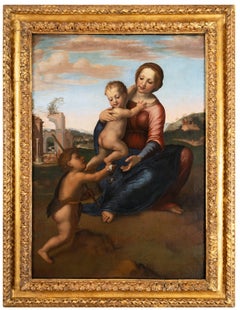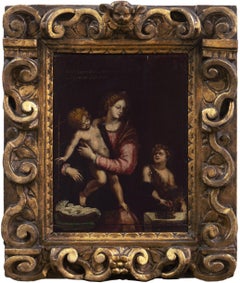Items Similar to Baptism of Christ
Want more images or videos?
Request additional images or videos from the seller
1 of 3
Borghese di PieroBaptism of Christca. 1450
ca. 1450
$60,000
£45,394.12
€52,391.85
CA$83,803.30
A$93,173.27
CHF 48,770.59
MX$1,142,739.25
NOK 620,972.90
SEK 586,272.01
DKK 390,965.18
Shipping
Retrieving quote...The 1stDibs Promise:
Authenticity Guarantee,
Money-Back Guarantee,
24-Hour Cancellation
About the Item
Provenance:
Achillito Chiesa, Milan
Luigi Albrighi, Florence, by 1 July 1955
with Marcello and Carlo Sestieri, Rome, 1969
Private Collection, Connecticut
Exhibited:
Mount Holyoke College Art Museum, South Hadley, Massachusetts (on loan, 2012)
Literature:
Carlo Volpe, “Alcune restituzioni al Maestro dei Santi Quirico e Giulitta,” in Quaderni di Emblema 2: Miscellanea di Bonsanti, Fahy, Francisci, Gardner, Mortari, Sestieri, Volpe, Zeri, Bergamo, 1973, pp. 19-20, fig. 18, as by the Master of Saints Quiricus and Julitta (now identified as Borghese di Piero).
This fine predella panel depicting the Baptism of Christ is the work of the Pisan artist Borghese di Piero, who was active in the first half of the fifteenth century. His identity was first established by Maria Teresa Filieri in a 1995 article publishing documentation of his authorship of the high altar of the church of San Quirico in the village of Cappanori, near Lucca. Previously, art historians—and, in particular, Roberto Longhi and Carlo Volpe—had established a corpus of works by an anonymous artist styled the Master of Saints Quiricus and Julitta, named after predella panels depicting those saints now in the Courtauld Institute of Art, London (Figs. 1-3). These in fact formed the predella of the altarpiece in Cappanori by Borghese di Piero. Further discoveries of documents related to the artist as well as works by him that remained in situ confirmed that his most significant period of activity was spent in Lucca, where he completed a fresco cycle in the chapel of Santa Caterina in the Carmelite church of San Piero Cigoli in the late 1450s.
Although he presumably trained in Pisa, the artist’s style is essentially Florentine but with some provincial qualities and an appealing sweetness in the characterization of his figures. The figure of Christ in this painting, standing in a relaxed pose in the River Jordan, is innocent and charming—as are the two angels at the lower right, bundled in their robes like members of a boys’ choir. John the Baptist is cleverly depicted with one foot on land and the other dipped into in the coursing river as he baptizes Christ with water poured out of the scallop shell held in his right hand. The haloes and garments of two more figures are seen at the left, but the rest of their bodies are missing, as the panel has been trimmed.
This painting was first classified among the works of Fra Angelico by Bernard Berenson, as recorded on a photograph annotated by him in the Fototeca Berenson. Later, Federico Zeri advanced the name of Battista di Gerio as its author. It was Carlo Volpe, in his 1973 article, who associated the panel with the Master of Saints Quiricus and Julitta, only later to be identified as Borghese di Piero.
Dr. Maria Teresa Filieri has confirmed the attribution of the present panel to Borghese di Piero (written communication). Filieri dates the work to the middle of the fifteenth century, roughly contemporary with the San Quirico di Cappanori altarpiece, which is documented in 1448.
- Creator:Borghese di Piero (1397 - 1463)
- Creation Year:ca. 1450
- Dimensions:Height: 9.5 in (24.13 cm)Width: 6.25 in (15.88 cm)
- Medium:
- Movement & Style:
- Period:
- Condition:
- Gallery Location:New York, NY
- Reference Number:1stDibs: LU1027005562
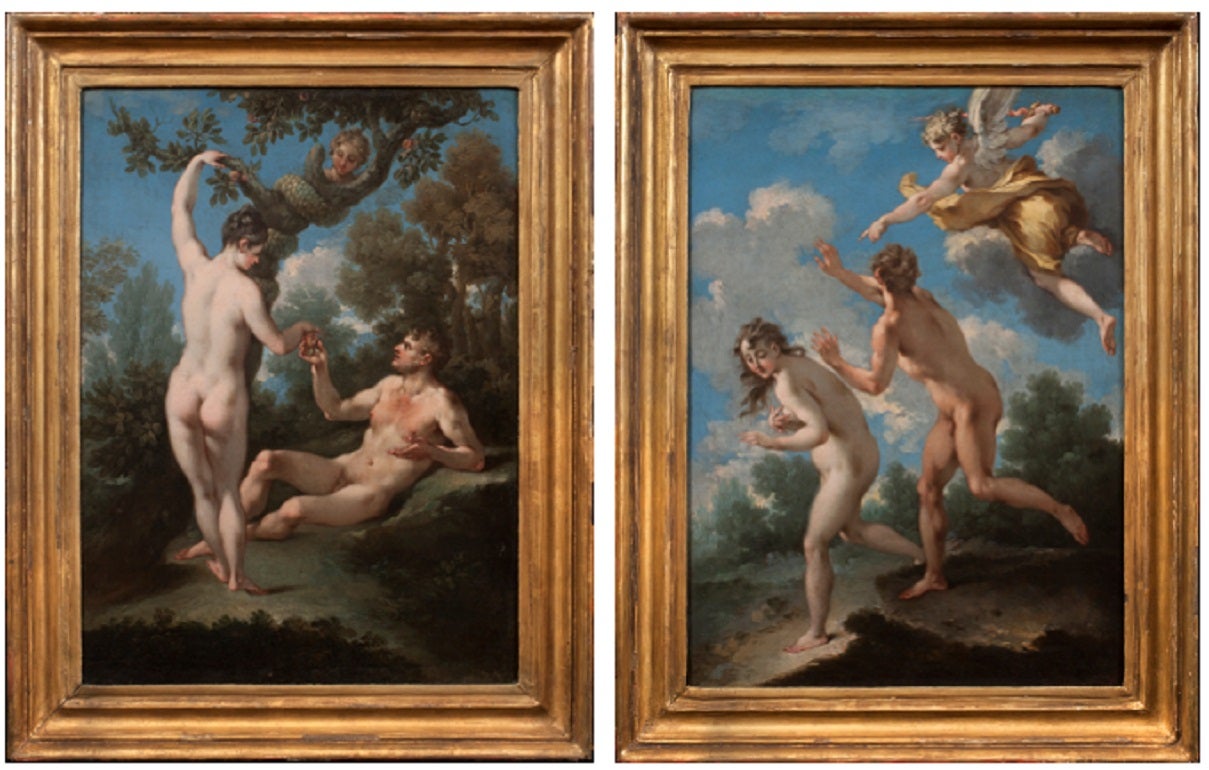
About the Seller
5.0
Recognized Seller
These prestigious sellers are industry leaders and represent the highest echelon for item quality and design.
Established in 1997
1stDibs seller since 2012
21 sales on 1stDibs
Typical response time: 8 hours
- ShippingRetrieving quote...Shipping from: New York, NY
- Return Policy
Authenticity Guarantee
In the unlikely event there’s an issue with an item’s authenticity, contact us within 1 year for a full refund. DetailsMoney-Back Guarantee
If your item is not as described, is damaged in transit, or does not arrive, contact us within 7 days for a full refund. Details24-Hour Cancellation
You have a 24-hour grace period in which to reconsider your purchase, with no questions asked.Vetted Professional Sellers
Our world-class sellers must adhere to strict standards for service and quality, maintaining the integrity of our listings.Price-Match Guarantee
If you find that a seller listed the same item for a lower price elsewhere, we’ll match it.Trusted Global Delivery
Our best-in-class carrier network provides specialized shipping options worldwide, including custom delivery.More From This Seller
View AllThe Resurrection of Christ
Located in New York, NY
Provenance:
with “Mr. Scheer,” Vienna, by July 1918; where acquired by:
Jindřich Waldes, Prague, 1918–1941; thence by descent to:
Private Collection, New York
Literature:
Rudolf Kuchynka, “České obrazy tabulové ve Waldesově obrazárně,” Památky archeologické, vol. 31 (1919), pp. 62-64, fig. 5.
Jaroslav Pešina, “K datování deskových obrazů ve Waldesově obrazárně,” Ročenka Kruhu pro Pěstování Dějin Umění: za rok (1934), pp. 131-137.
Jaroslav Pešina, Pozdně gotické deskové malířství v Čechách, Prague, 1940, pp. 150-151, 220.
Patrik Šimon, Jindřich Waldes: sběratel umění, Prague, 2001, pp. 166, 168, footnote 190.
Ivo Hlobil, “Tři gotické obrazy ze sbírky Jindřicha Waldese,” Umění, vol. 52, no. 4 (2004), p. 369.
Executed sometime in the 1380s or 1390s by a close associate of the Master of the
Třeboň Altarpiece, this impressive panel is a rare work created at the royal court in Prague and a significant re-discovery for the corpus of early Bohemian painting. It has emerged from an American collection, descendants of the celebrated Czech industrialist and collector Jindřich Waldes, who died in Havana fleeing Nazi-occupied Europe.
The distinctive visual tradition of the Bohemian school first began to take shape in the middle of the fourteenth century after Charles IV—King of Bohemia and later Holy Roman Emperor—established Prague as a major artistic center. The influx of foreign artists and the importation of significant works of art from across Europe had a profound influence on the development of a local pictorial style. Early Italian paintings, especially those by Sienese painters and Tommaso da Modena (who worked at Charles IV’s court), had a considerable impact on the first generation of Bohemian painters. Although this influence is still felt in the brilliant gold ground and the delicate tooling of the present work, the author of this painting appears to be responding more to the paintings of his predecessors in Prague than to foreign influences.
This Resurrection of Christ employs a compositional format that was popular throughout the late medieval period but was particularly pervasive in Bohemian painting. Christ is shown sitting atop a pink marble sarcophagus, stepping down onto the ground with one bare foot. He blesses the viewer with his right hand, while in his left he holds a triumphal cross with a fluttering banner, symbolizing his victory over death. Several Roman soldiers doze at the base of the tomb, except for one grotesque figure, who, beginning to wake, shields his eyes from the light and looks on with a face of bewilderment as Christ emerges from his tomb. Christ is wrapped in a striking red robe with a blue interior lining, the colors of which vary subtly in the changing light. He stands out prominently against the gold backdrop, which is interrupted only by the abstractly rendered landscape and trees on either side of him.
The soldiers’ armor is rendered in exacting detail, the cool gray of the metal contrasting with the earth tones of the outer garments. The sleeping soldier set within a jumble of armor with neither face nor hands exposed, is covered with what appears to be a shield emblazoned with two flies on a white field, somewhat resembling a cartouche (Fig. 1). This may be a heraldic device of the altarpiece’s patron or it may signify evil, referencing either the Roman soldiers or death, over both of which Christ triumphs.
This painting formed part of the collection assembled by the Czech industrialist and founder of the Waldes Koh-i-noor Company, Jindřich Waldes, in the early twentieth century. As a collector he is best remembered for establishing the Waldes Museum in Prague to house his collection of buttons (totaling nearly 70,000 items), as well as for being the primary patron of the modernist painter František Kupka. Waldes was also an avid collector of older art, and he approached his collecting activity with the goal of creating an encyclopedic collection of Czech art from the medieval period through to the then-present day. At the conclusion of two decades of collecting, his inventory counted 2331 paintings and drawings, 4764 prints, and 162 sculptures. This collection, which constituted the Waldesova Obrazárna (Waldes Picture Gallery), was first displayed in Waldes’ home in Prague at 44 Americká Street and later at his newly built Villa Marie at 12 Koperníkova Street. This Resurrection of Christ retains its frame from the Waldes Picture Gallery, including its original plaque “173 / Česky malíř z konce 14 stol.” (“Czech painter from the end of the 14th century”) and Waldes’ collection label on the reverse.
The Resurrection of Christ was one of the most significant late medieval panel...
Category
15th Century and Earlier Old Masters Paintings
Materials
Tempera, Panel
Rebecca at the Well
Located in New York, NY
Provenance:
Dr. James Henry Lancashire, Manchester-by-the-Sea, Massachusetts, by 1925; probably by descent to:
Private Collection, Cumberland Foreside, Maine, until 2018
This unpublished panel is a characteristic work of the Master of the Apollo and Daphne Legend, an anonymous Florentine painter in the circle of Bartolommeo di Giovanni, Domenico Ghirlandaio, and Sandro Botticelli. The artistic personality of the Master of the Apollo and Daphne Legend was independently recognized by Everett Fahy and Federico Zeri at roughly the same moment in time. Fahy originally dubbed this artist the Master of the Ryerson Panels but later adopted Zeri’s name for the artist, which derives from his eponymous works from the Samuel H. Kress collection (Figs. 1-2). Fahy posited that the artist was most likely a pupil of Ghirlandaio active from roughly 1480 to 1510, and that he may be identifiable with one of Ghirlandaio’s documented pupils to whom no works have been securely attributed, such as Niccolò Cieco, Jacopo dell’Indaco, or Baldino Baldinetti. The present painting was first attributed to this master by Everett Fahy in 1989, who became aware of its existence only after publishing his definitive studies on the artist.
The surviving body of work by the Master of the Apollo and Daphne Legend is largely composed of series of panels treating the same theme. In addition to the works illustrating the legend of Apollo and Daphne, there are also series on the themes of Susanna and the Elders and the story of Saint Joseph, among others. The subject of the present panel is drawn from Genesis 24, the story of Isaac. It is possible that our painting relates to another work by the artist depicting the Sacrifice of Isaac formerly in the collection of E. A. McGuire in Dublin, Ireland (Fig. 3), and that these two panels were originally part of a decorative scheme based on the story of Isaac.
Although the Master’s paintings of this type have traditionally been considered painted fronts of wedding chests, known as cassoni, the scale of these paintings and the fact that they are often part of a series indicates that they are more likely spalliera panels—paintings set into furniture or the wainscoting of a room. The biblical episode depicted in this painting centers on the theme of marriage, which suggests that this work was likely commissioned for the domestic interior of a newly married couple. The Master has transcribed into paint even the minute details of this Old Testament story, in which Abraham sends a servant to travel by camel to the land of his father and seek out a wife for his son Isaac. The servant is here shown at the well...
Category
15th Century and Earlier Old Masters Figurative Paintings
Materials
Oil, Tempera, Wood Panel
Joseph Holding the Christ Child
By Pietro Bardellino
Located in New York, NY
Provenance: Private Collection, Argentina.
A work of great delicacy and intimacy, this small painting on copper by Pietro Bardellino treats a subject which grew in popularity during the Baroque period: Saint Joseph and the Christ child...
Category
18th Century Baroque Paintings
Materials
Copper
A Guardian Angel and a Child
Located in New York, NY
Provenance:
Cornelius Vanderbilt, New York; by whom gifted in 1880 to:
The Metropolitan Museum of Art, New York (80.3.673); deaccessioned and sold:
Christie’s, New York, 12 June 19...
Category
17th Century Old Masters Portrait Paintings
Materials
Terracotta, Gesso
Madonna and Child with Angels in the Clouds
Located in New York, NY
Provenance: Charles H. and Virginia Baldwin, Claremont, Colorado Springs, Colorado ca. 1907-1934; thence by descent until sold in 1949 to:
Charles Blevins Davis, Claremont (renamed Trianon), Colorado Springs 1949 -until gifted in 1952 to:
The Poor Sisters of Saint Francis, Trianon, Colorado Springs, 1952 until acquired, 1960, by:
John W. Metzger, Trianon, renamed as the Trianon School of Fine Arts, Colorado Springs, 1960-1967; when transferred to:
The Metzger Family Foundation, Trianon Art Museum, Denver, 1967 - 2004; thence by descent in the Metzger Family until 2015
Exhibited: Trianon Art Museum, Denver (until 2004)
The present work is a spectacular jewel-like canvas by Amigoni, rich in delicate pastel colors, most likely a modello for an altarpiece either lost or never painted. In it the Madonna stands firmly upon a cloud in the heavens, her Child resting on a delicate veil further supported by a cloud, as he gently wraps his arm around his mother’s neck. From above angels prepare to lower flowers and a wreath, while other angels and seraphim surrounding the two joyfully cavort.
Dr. Annalisa Scarpa, author of the forthcoming monograph on Jacopo Amigoni...
Category
18th Century and Earlier Figurative Paintings
Materials
Canvas, Oil
The Assumption of the Virgin
Located in New York, NY
Provenance:
Unidentified collector’s mark “D.G.R,” lower right (Lugt 757b)
Wilhelm Suida (1877–1959), New York; by descent to:
Robert L. and Bertina Suida Manning, New York, until 1996
Private Collection, USA
This impressive drawing of the Assumption of the Virgin is the work of the Genoese artist Giovanni Battista Paggi. The son of a nobleman, Paggi received a humanist education and was a self-taught artist. According to Paggi’s first biographer, Raffaele Soprani, it was only after encountering Luca...
Category
16th Century Old Masters Figurative Drawings and Watercolors
Materials
Paper, Ink, Pen
You May Also Like
17th century Italian school, The Virgin and Child with Saint John the Baptist
Located in PARIS, FR
17th century Italian School
The Virgin and Child with Saint John the Baptist
Oil on canvas
Dimensions: h. 106 cm, l. 77 cm
Important 17th century Italian carved giltwood frame
Fram...
Category
17th Century Old Masters Figurative Paintings
Materials
Canvas, Oil
Saint John the Baptist Paint Pasinelli 17th Century Oil on canvas Old master
Located in Riva del Garda, IT
Lorenzo Pasinelli (Bologna, 1629 - 1700)
Sermon of Saint John the Baptist Circa 1650.
Oil on canvas 115 x 154 cm With frame 136 x 174 cm
Provenance Milan, Porro 6 June 2006 ...
Category
17th Century Old Masters Paintings
Materials
Oil
$24,658 Sale Price
20% Off
'Mary with Jesus and St. John the Baptist', 17th Century Milanese School Oil
Located in Santa Cruz, CA
A late 17th century, devotional oil showing the Virgin Mary with Jesus and St. John the Baptist. Displayed in a fine and period, hand-carved and gilt-wood frame.
Framed dimensions: ...
Category
Mid-17th Century Figurative Paintings
Materials
Gold Leaf
Italian Renaissance Tempera on Parchment Painting Holy Family by Giuseppe Cesari
Located in Portland, OR
A rare & important Italian Renaissance tempera on parchment painting, Giuseppe Cesari Il Cavalier d'Arpino (Giuseppe Cesari, 1568-1640), the painting c...
Category
16th Century Renaissance Figurative Paintings
Materials
Parchment Paper, Egg Tempera
Baptism Antique Gallery of Florence - Vintage Photo - Early 20th century
Located in Roma, IT
Baptism Antique Gallery of Florence - Vintage Photo is a black and white photograph of the early 20th century
Good conditions, aged with foxing.
Category
Early 20th Century Modern Figurative Photography
Materials
Photographic Paper
16th Century by Venetian Maestro Deposition of Christ Oil on Panel
Located in Milano, Lombardia
16th Century Venetian Maestro
Title: Deposition of Christ
Medium: Oil on panel
Dimensions: without frame 40 x 25 cm
Formerly Canesso Collection, Paris.
Fairs: The International Biennial of Antiques in Florence 2022 (BIAF, Biennale Internazionale dell’Antiquariato di Firenze)
Publications: Bozzetti, modelletti, sketches: dalla collezione di Giorgio Baratti (From the Giorgio Baratti Collection) curated by Anna Orlando, Agnese Marengo and Annalisa Scarpa, Genoa, 2022, pp. 22, 23.
In this precious panel we can admire a lament over the body of Christ by a large group of bystanders among whom we can recognise the Virgin and, in the foreground, St Catherine of Alexandria...
Category
16th Century Old Masters Figurative Paintings
Materials
Oil, Wood Panel
